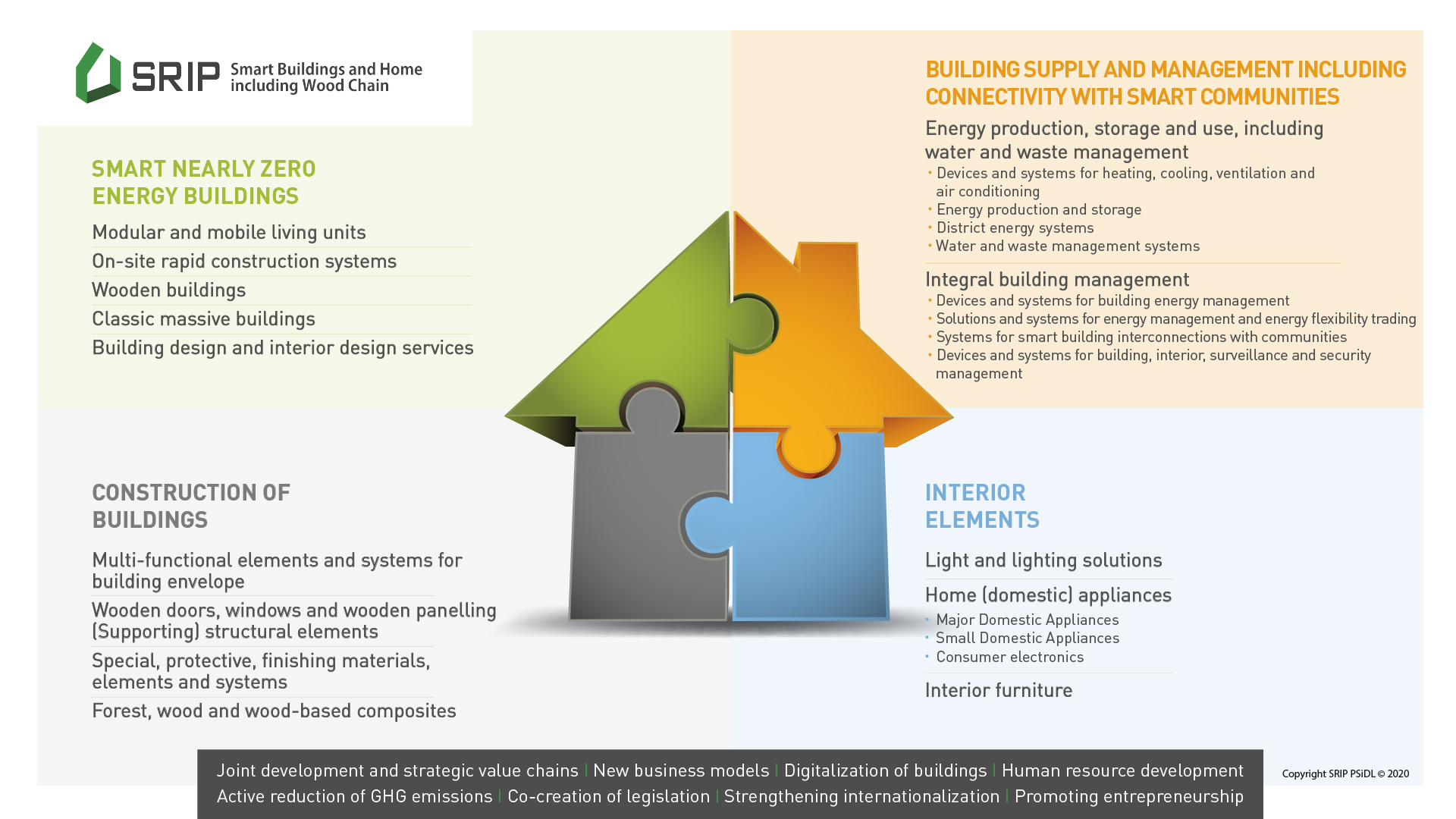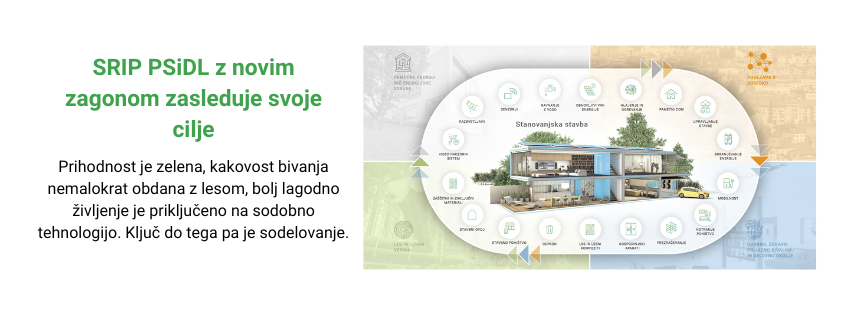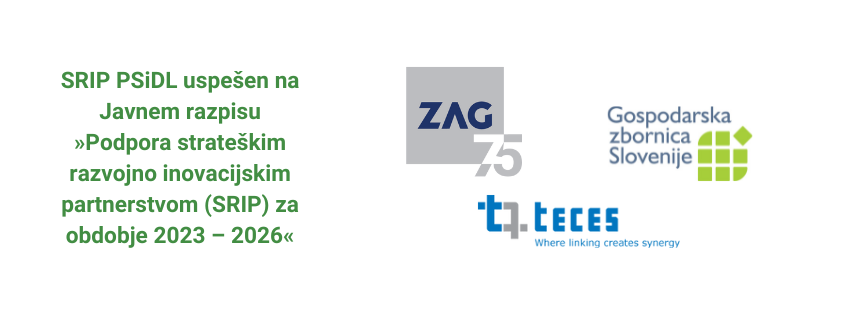The scope of the SRIP PSiDL project identifies the narrow product directions that form the basis of the SRIP's activities, as well as the topics with the highest concentration of competences and capacities of the SRIP members. The individual product directions are grouped into 4 focus areas. These comprise a group of product directions that are necessary for a complete whole or segment of a building. Within the focus areas, SRIP members work on a broader, more general level.
This is based on the individual product lines, which are understood as a group of related products within the provision of the same or similar or complementary functions. The product lines are the foundation of the operation of the PSiDL SRIP, the unit where the members of the partnership most directly identify themselves as partners in common activities. The support of the SRIP PSiDL project to bringing partners together in the areas of joint development and strategic value chains, digitisation, validation of new business models and addressing common problems such as internationalisation, human resources, legislation, entrepreneurship, etc., represent areas where the SRIP PSiDL can make a real contribution in terms of added value and benefits for its members.
The basis for joint activities and the integration of different products and services into a coherent and interwoven whole is the newly defined four focus areas
- Construction of Buildings,
- Interior Elements,
- Building Care and Management Combined with Connectivity to the Neighbourhood
- Smart Nearly Zero Energy Buildings.
The schematic structure of each focus area groups and the corresponding product is presented in the figure below: 
Focus Area: Construction of Buildings
The focus area "Construction of Buildings" brings together Slovenian manufacturers of materials and solutions that are mainly involved in the construction of buildings in the traditional way, as well as manufacturers of materials and solutions that can be used in the construction of prefabricated buildings. These include multifunctional building envelope elements, (load-bearing) structural elements, special, protective and finishing materials, elements and systems, as well as joinery (windows and doors, stairs) and timber cladding. As a specific product line, which is specific - it trades almost exclusively on a B2B basis and provides raw material, thus representing the start of value chains - is the product line Forest, Wood and Wood Composites. The characteristic of the focus area is that the value chains are quite intertwined, as the individual product lines are integrated already at the level of the focus area into a larger unit (e.g. an external wall), which is further integrated into the building and further into the neighbourhood.
The focus area comprises the product directions:
- (load-bearing) structural elements and systems,
- multifunctional building envelope elements and systems,
- protective and finishing materials, elements and systems,
- joinery (windows and doors, stairs) and wood cladding; and
- wood, timber and wood composites.
Focus Area: Interior Elements
The Interior Elements focus area brings together products that are not part of the construction process, but are part of the interior design and are usually brought into the building afterwards.
The focus area comprises three product lines; home appliances, light and lighting solutions and interior furniture.
The Home Appliances product area covers the development and production of all types of electrical appliances and their components that are part of everyday household tasks.
- The Home Appliances product line covers the development and production of all types of electrical appliances and their components that are part of everyday household tasks.
They are broadly divided into three main categories or product families, such as- major domestic appliances (MDAs), which include refrigerators, freezers, washing machines, tumble dryers, ovens, cookers, hobs, cooker hoods, dishwashers, microwave ovens, etc,
- small domestic appliances (SDAs), which are divided into three sub-categories according to their purpose: convenience (vacuum cleaners, irons, air purifiers, humidifiers, etc.), kitchen utensils (food preparation, blenders, blenders, choppers, coffee machines, kettles, etc.) and personal care (hair care, shavers, trimmers, oral hygiene, other, etc.); and
- consumer electronics, which are divided into three sub-categories according to their intended use: entertainment (TV sets, audio and video players, music towers, home cinema systems, speakers, radios, projectors, games consoles, etc.), communications (telephones, mobile phones, etc.) and home office (computers, tablets, printers, scanners, etc.).
-
The product line "Light and Lighting Solutions" covers the development of lighting as end products that are selected by the user and easily connected to energy in their own environment for use. It also includes lighting solutions of all kinds, which are complex and integrated and require the design of artificial light, the integration of luminaires, lighting elements and light sources and other components for high-quality, user-friendly, flexible artificial lighting.
The product line "Interior Furniture" covers a wide range of furniture, from office furniture to furniture for hotels, yachts and home furnishings (kitchens, bedrooms, children's rooms, etc.). This furniture can be manufactured in an industrial or artisanal manner. Kitchen furniture is a particularly important integrator, integrating with household appliances. In addition, engineering, the creation of integrated solutions for furniture production, or the furnishing of buildings, has a strong presence in Slovenia.
Focus Area: Building Care and Management Combined with Connectivity to the Neighbourhood
The very broad focus area Building Supply and Management and Connectivity to the Neighbourhood brings together devices, systems and services that, together with the interior, enable the building itself to function and be managed in accordance with the requirements of the user or the given environment, while at the same time providing a seamless connection between the building and the neighbourhood and the urban infrastructure.
The focus area comprises two broad product lines:
- Energy generation, storage and use, water and waste management covers solutions, devices, systems and components for the generation, storage and use of heat, cooling and electricity. It also covers the external and internal distribution of heating and cooling energy, including the preparation, filtration, recuperation and distribution of fresh air or exhaust air within a building, and the management of water and waste in/near buildings, and related devices, systems and components.
Fokusno področje obsega dve obsežni produktni smeri:
- Proizvodnja, shranjevanje in raba energije ter ravnanje z vodo in odpadki obsega rešitve, naprave, sisteme in komponente za proizvodnjo, shranjevanje ter rabo toplote, hladilne energije in elektrike. Navezuje se tudi na zunanjo in interno distribucijo energentov za ogrevanje in hlajenje, vključno s pripravo, filtriranjem, rekuperacijo in distribucijo svežega zraka ali odvodom odpadnega zraka v stavbi, ter na ravnanje z vodo in odpadki v/pri stavbah ter s tem povezanimi napravami, sistemi in njihovimi komponentami.
The product line covers product families such as devices and systems
- for heating, cooling, ventilation and air conditioning,
- energy (co)generation and storage,
- district energy supply, and
- water and waste management.
-
Integrated building management encompasses all the devices, systems and solution providers used to manage a building in the areas of safety, comfort and running costs.
The product line covers product and service families such as devices, systems and solutions- for energy management in buildings,
- for the management and trading of energy resilience,
- building, interior, safety and security management, and
- connecting smart buildings to the neighbourhood.
Focus Area: Smart Nearly Zero Energy BuildingsPametne skoraj nič-energijske stavbe
Fokusno področje »Pametne skoraj nič energijske (SNeS) stavbe« je integracijsko področje, v katerem poleg proizvajalcev nastopajo deležniki inovativnega projektiranja in oblikovanja, ki številne gradbene in druge proizvode združijo v osnoven, a kompleksen gradnik trajnostne gradnje stavbe.
The focus area "Smart Nearly Zero Energy (SNeS) Buildings" is an integrative area where innovative design and engineering stakeholders, alongside manufacturers, bring together a wide range of building and other products into a basic but complex building block of sustainable building construction.
The focus area comprises the product lines with the most integrated product level:
- Building design and interior design services: includes integral product lines such as modular and mobile living units, fast-track on-site construction systems, timber buildings (with frame and cross-laminated timber (CLT) construction) and conventional solid buildings.
- Modular and mobile living units: on living modules designed for custom assembly or as a finished product for direct erection on site, the latter being relocatable as required. They can be erected and assembled on site in a very short time into large and complex buildings with different functions (schools, kindergartens, military bases, refugee centres, etc.) on a temporary ready-to-use platform with installation connections.
-
Fast-track on-site construction systems: enabling faster, technically and technologically sophisticated construction. Thanks to the technological solutions designed, this type of construction consists of the simple assembly of prefabricated elements that perform several functions: for example, the formwork function for the concreting of the walls and the base slab and, at the same time, the thermal protection function, including thermal bridging solutions.
-
Timber buildings: covers the different ways of constructing buildings where timber and timber-based materials are used as the predominant building element. This includes both skeleton buildings, cross-laminated timber (CLT) buildings and log cabins.
-
Classic solid buildings: covers all types of buildings designed to be constructed on site in a classic manner over time, irrespective of the type of materials used.









